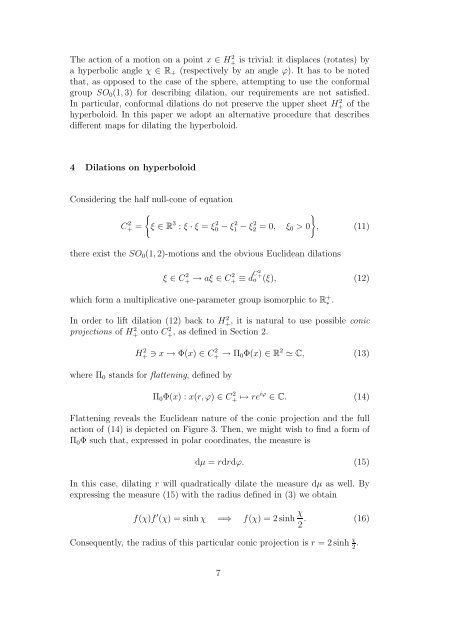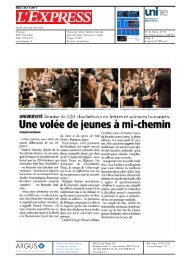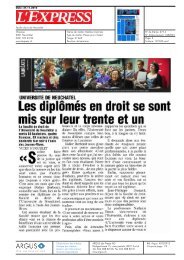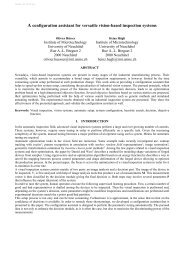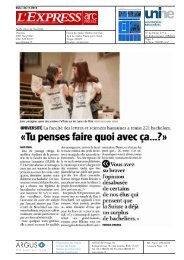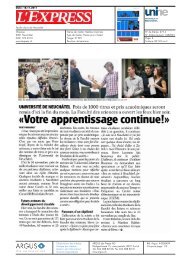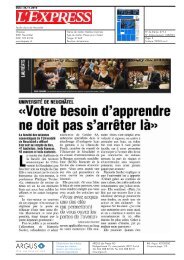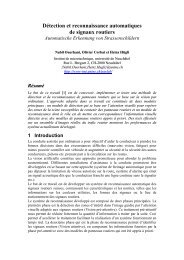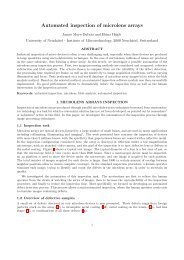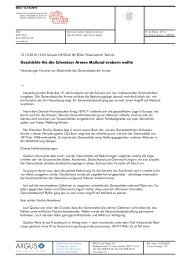Continuous Wavelet Transform on the Hyperboloid - Université de ...
Continuous Wavelet Transform on the Hyperboloid - Université de ...
Continuous Wavelet Transform on the Hyperboloid - Université de ...
You also want an ePaper? Increase the reach of your titles
YUMPU automatically turns print PDFs into web optimized ePapers that Google loves.
The acti<strong>on</strong> of a moti<strong>on</strong> <strong>on</strong> a point x ∈ H+ 2 is trivial: it displaces (rotates) by<br />
a hyperbolic angle χ ∈ R + (respectively by an angle ϕ). It has to be noted<br />
that, as opposed to <strong>the</strong> case of <strong>the</strong> sphere, attempting to use <strong>the</strong> c<strong>on</strong>formal<br />
group SO 0 (1, 3) for <strong>de</strong>scribing dilati<strong>on</strong>, our requirements are not satisfied.<br />
In particular, c<strong>on</strong>formal dilati<strong>on</strong>s do not preserve <strong>the</strong> upper sheet H+ 2 of <strong>the</strong><br />
hyperboloid. In this paper we adopt an alternative procedure that <strong>de</strong>scribes<br />
different maps for dilating <strong>the</strong> hyperboloid.<br />
4 Dilati<strong>on</strong>s <strong>on</strong> hyperboloid<br />
C<strong>on</strong>si<strong>de</strong>ring <strong>the</strong> half null-c<strong>on</strong>e of equati<strong>on</strong><br />
{<br />
}<br />
C+ 2 = ξ ∈ R 3 : ξ · ξ = ξ0 2 − ξ1 2 − ξ2 2 =0, ξ 0 > 0 , (11)<br />
<strong>the</strong>re exist <strong>the</strong> SO 0 (1, 2)-moti<strong>on</strong>s and <strong>the</strong> obvious Eucli<strong>de</strong>an dilati<strong>on</strong>s<br />
ξ ∈ C 2 + → aξ ∈ C2 + ≡ dC2 +<br />
a (ξ), (12)<br />
which form a multiplicative <strong>on</strong>e-parameter group isomorphic to R + ∗ .<br />
In or<strong>de</strong>r to lift dilati<strong>on</strong> (12) back to H+ 2 , it is natural to use possible c<strong>on</strong>ic<br />
projecti<strong>on</strong>s of H+ 2 <strong>on</strong>to C2 + , as <strong>de</strong>fined in Secti<strong>on</strong> 2.<br />
H 2 + ∋ x → Φ(x) ∈ C2 + → Π 0Φ(x) ∈ R 2 ≃ C, (13)<br />
where Π 0 stands for flattening, <strong>de</strong>fined by<br />
Π 0 Φ(x) :x(r, ϕ) ∈ C 2 + ↦→ reiϕ ∈ C. (14)<br />
Flattening reveals <strong>the</strong> Eucli<strong>de</strong>an nature of <strong>the</strong> c<strong>on</strong>ic projecti<strong>on</strong> and <strong>the</strong> full<br />
acti<strong>on</strong> of (14) is <strong>de</strong>picted <strong>on</strong> Figure 3. Then, we might wish to find a form of<br />
Π 0 Φ such that, expressed in polar coordinates, <strong>the</strong> measure is<br />
dµ = rdrdϕ. (15)<br />
In this case, dilating r will quadratically dilate <strong>the</strong> measure dµ as well. By<br />
expressing <strong>the</strong> measure (15) with <strong>the</strong> radius <strong>de</strong>fined in (3) we obtain<br />
f(χ)f ′ (χ) =sinhχ =⇒ f(χ) =2sinh χ 2 . (16)<br />
C<strong>on</strong>sequently, <strong>the</strong> radius of this particular c<strong>on</strong>ic projecti<strong>on</strong> is r =2sinh χ 2 .<br />
7


